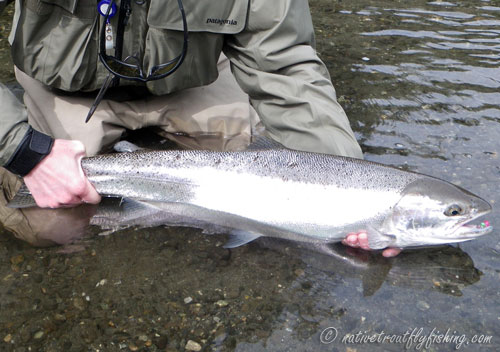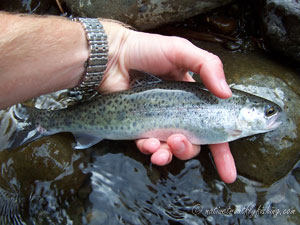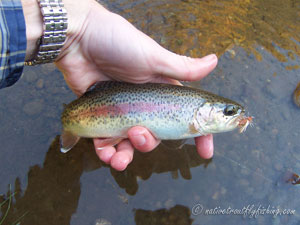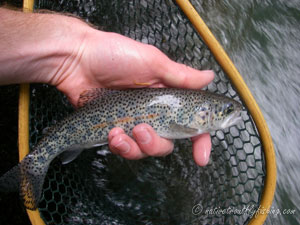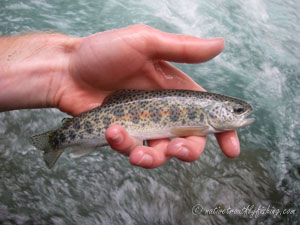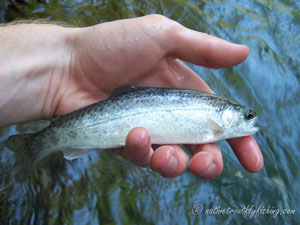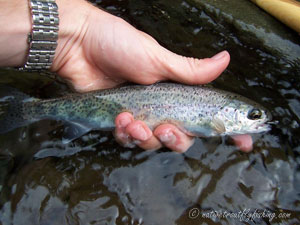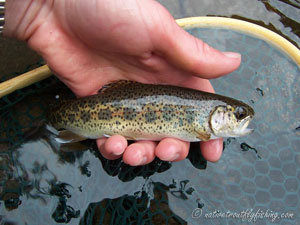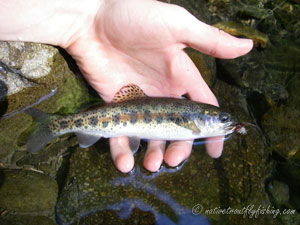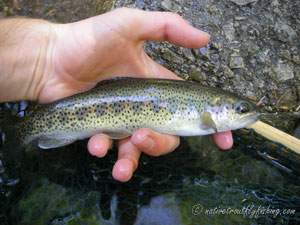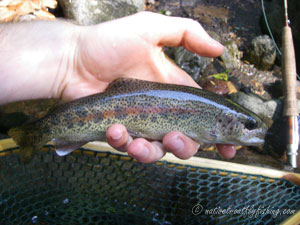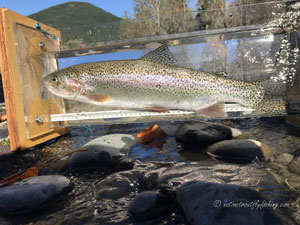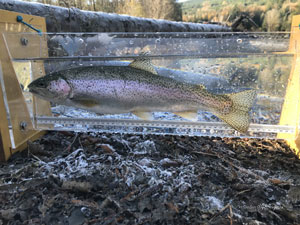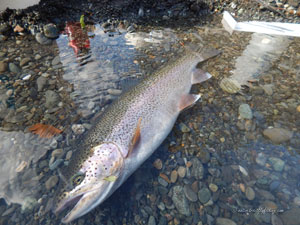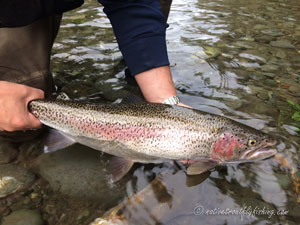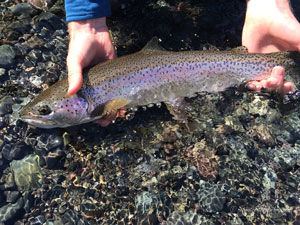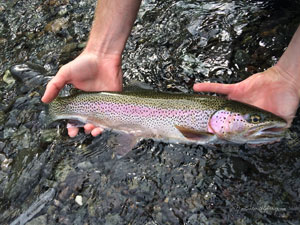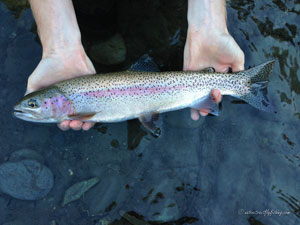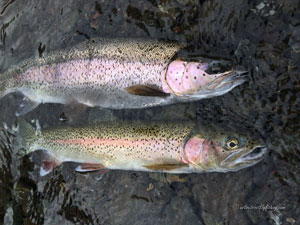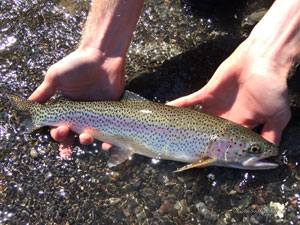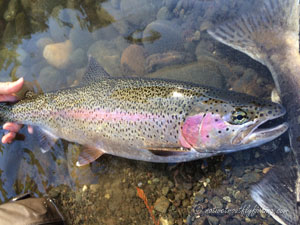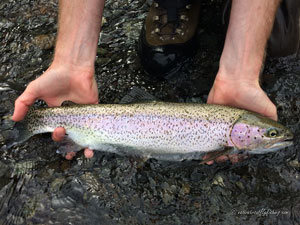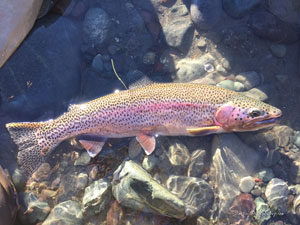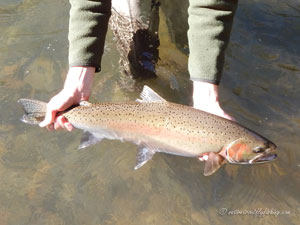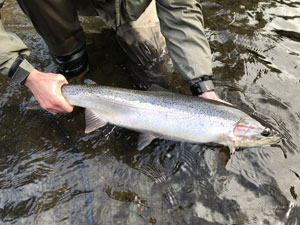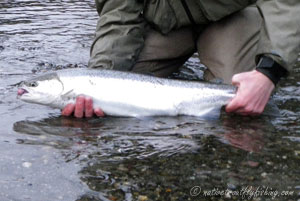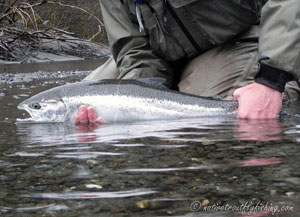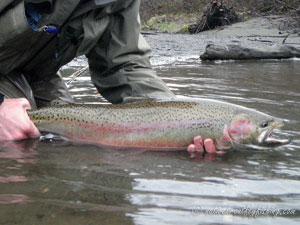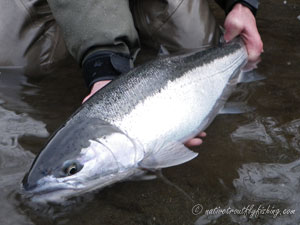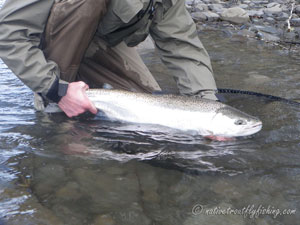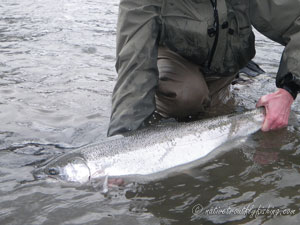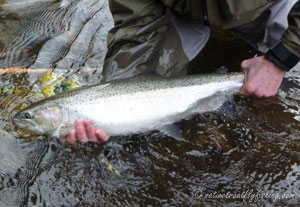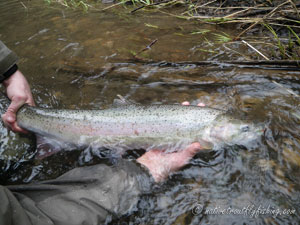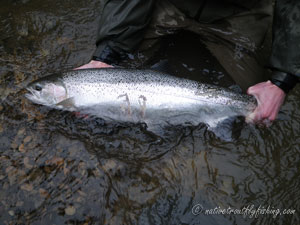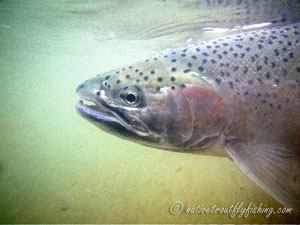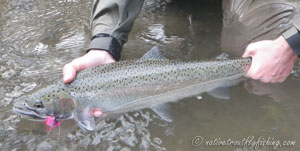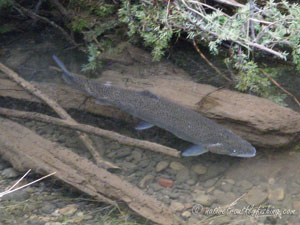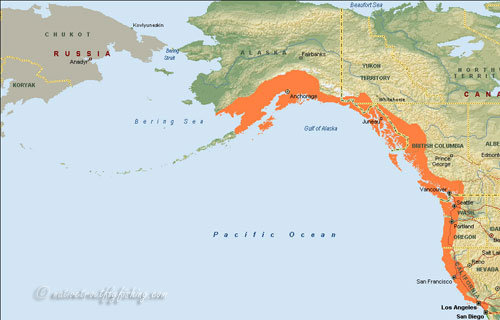Coastal Rainbow Trout
Oncorhynchus mykiss irideus
A bright Steelhead; the anadromous form of the Coastal Rainbow trout from Southeast Alaska
Introduction
The Coastal Rainbow Trout is a subspecies of Rainbow Trout native to the Pacific Coast of North America from the Kuskokwim River in Alaska to Otay River in Southern California. Coastal Rainbow Trout are found on the western side of the Cascade Mountains and downstream of Hell’s Gate on the Fraser River in Canada. However, genetic evidence is not as clear about a clear separation between Coastal and Interior forms of O. mykiss with soome studies suggesting that the subspecies boundaries may not be as clear cut, while others support a transtion zone at the Cascade crest (McCusker et al. 2000, Blankenship et al. 2011). In the Sacramento River drainage, they are found as far upstream as the McCloud and Pit Rivers, but there appears to be a transition zone in the basin with intermediate forms of Coastal Rainbow Trout and Redbands (Behnke 2002). Coastal Rainbow Trout in the Klamath Mountain region of are genetically distinct from other populations and likely represent an intermediate form between Redbands and Coastal Rainbow Trout (Currens et al. 2009). Coastal Rainbow Trout are a highly sought-after game fish and has been largely worked into the hatchery Rainbow Trout broodstock. The anadromous form of this fish is commonly called Steelhead, due to their hard heads and silvery appearance when fresh from the saltwater. The world record Steelhead as caught in the Skeena River in British Columbia Canada and weighed 42lbs (19.1 kg) (Behnke 2002), although larger fish have been caught in commercial fisheries. The Kamchatkan Rainbow Trout in Russia are considered a separate subspecies Oncorhynchus mykiss mykiss, however both genetics and taxonomic characteristics indicate that they are very recently derived from Coastal Rainbow Trout and likely should be considered a single subspecies (Behnke 1992, McCusker et al. 2000). Under some classifications the Baja Rainbow Trout or Nelson’s Trout Oncorhynchus mykiss nelsoni of Rio Santo Domingo in Baja Mexico are included with Coastal Rainbow Trout as the southernmost population, a classification that is supported by genetics evidence that shows a close relationship with populations in souther California (Behnke 2002, Abadia-Cardoso et al. 2016).
Life History Information
The Coastal Rainbow Trout exhibit a wide range of life history strategies including stream resident, fluvial (river migratory) and anadromous (sea-run) populations. While they also exhibit adfluvial (river-lake migrant) populations, these are not as common in Coastal Rainbow Trout as they are in the Redband Trout subspecies. Coastal Rainbow Trout spawn during the spring and are iteroparous meaning that some fish survive spawning and are able to spawn multiple times.
Stream Resident and Fluvial Form
Stream resident populations of Coastal Rainbow Trout remain in their natal stream throughout their entire life. These fish establish territories and are predominately drift feeders on a variety of aquatic and terrestrial insects and may also prey on small fish. Many of the streams along Pacific Coast are nutrient poor and as such food is a limiting factor and there is often little opportunity for growth past the age-3 for stream resident trout. However, in places where salmon provide annual subsidies of food in the form of eggs, fry and flesh Coastal Rainbow Trout may attain much larger sizes. In two Washington stream reaches above barriers that salmon could not access, maximum size of stream resident fish is often 14” (36 cm) with a maximum lifespan of about 6 years, however below the barriers Coastal Rainbow Trout commonly reached sizes of 20” (50cm) with a maximum lifespan of 8 years (Marston 2017). However, after several years of poor salmon returns, the abundance of fish over 20” (50cm) in these watersheds declined significantly. In the Kanektok River in Alaska, Coastal Rainbow Trout ranged from 8” to 23” (21-58 cm) and age-3 to age-10 but were found to travel less than 6.5 miles (10 km) annually (Adams 1996), indicating that they likely represented a stream resident form. Fluvial life histories are common in river systems with salmon, with Rainbow Trout migrating throughout the watershed to take advantage of different salmon runs and thermal refugia as well as to reach their spawning grounds (Alt 1987, Lisac 1996, Meka et al. 2000). During salmon spawning season, Rainbow Trout often move more than they do prior to the arrival of salmon, likely to seek out food as well as to avoid territorial salmon, which may attack trout (Fraley et al. 2017). I have observed that when salmon abundances are high, Coastal Rainbow Trout will seek out the fastest water, just downstream of salmon aggregations to both avoid territorial salmon and to take advantage drifting salmon eggs. Spawning in stream resident and fluvial populations, typically takes place between age-2 and age-4 with males typically spawning at younger ages than females (Behnke 2002).
Adfluvial Form
Adfluvial populations of Coastal Rainbow Trout are relatively rare across their native range when compared with the Redband subspecies, and as such remain poorly studied compared with other life history types. Many adfluvial populations of Coastal Rainbow Trout found in reservoirs above barrier dams are descendants of former steelhead populations (Leitwein et al. 2016, Pearse and Campbell 2018, Winans et al. 2017) and when the dams are removed, they often transition back to anadromous life history types (Fraik et al. 2021). In a natural lake in southwest Alaska, Arostegui et al. (2019) showed that adfluvial Coastal Rainbow Trout were genetically unique from fluvial life history types in the basin, indicating that there is some level of genetic control over the life history type as well as segregation in spawning overlap with the fluvial populations. While stream dwelling Coastal Rainbow Trout in Alaska feed primarily on aquatic insects, adfluvial Rainbow Trout in Lake Iliamna feed primarily on benthic snails and amphipods, with both life history forms feeding heavily on Sockeye Salmon eggs when they were available (Arostegui and Quinn 2018). Larger adfluvial Coastal Rainbow Trout typically shift to preying primarily on other fish, with juvenile Sockeye Salmon or Kokanee being primary sources of food in many populations (Schwanke and Hubert 2003). Adfluvial life history forms appear to exhibit variable strategies in how they utilize lakes. In Naknek Lake, Alaska adfluvial fish typically spawn at age-5 to age-7, with spawning occurring in the lake outlet (known as an allacustrine life history). After spawning these fish moved back into the lake, but in the fall and early winter moved back to the river to overwinter (Schwanke and Hubert 2003). In the lakes of the Bristol Bay region of southwestern Alaska, two forms of adfluvial Coastal Rainbow Trout have been observed. One of these occupies they lake as their primary rearing and foraging area and only migrates into streams for spawning, while the other form forages primarily in streams but uses lakes as migratory corridors (Meka et al. 2003, Bentley et al. 2015, Arostegui et al. 2018).
A unique population of adfluvial Coastal Rainbow Trout called the Beardslee Trout is found in Crescent Lake in the Olympic National Park in Washington State. These fish, along with the native Coastal Cutthroat and Kokanee lost access to the salt water when the lake's outlet was blocked by a landslide isolating them in the lake. Although Beardslee Trout were once considered to be a distinct subspecies of Rainbow Trout they are now recognized as a unique life history form (Behnke 1979). Beardslee Trout are a deep-water fish, that specialize as a predator of the Kokanee in the lake and as such grow to reach sizes of up to 23lbs (10.4 kg). The Beardslee Trout have avoided hybridizing with the Cutthroat in the lake by using the lake’s outlet as their primary spawning habitat. While one of the lake’s two Cutthroat populations also uses the outlet, they spawn earlier than the Beardslee Trout. Spawning for the Beardslee Trout occurs from January to May, with juveniles emerging March 18 to July 30 (Brenkman et al. 2014). Morphologically the Beardslee Trout are silvery with deep bodies and they have been shown to be genetically divergent from other nearby Coastal Rainbow Trout populations.
Anadromous Form
The anadromous life history form of Coastal Rainbow Trout or Steelhead was historically found from the San Diego area of Southern California to the northern side of the Alaskan Peninsula (Behnke 2002). Anadromy in Coastal Rainbow Trout appears to be both genetically and environmentally influenced across their range (Hayes et al. 2012, Kendall et al. 2015). While genetics influence life history type, stream resident or fluvial parents have been known to produce anadromous offspring and steelhead parents may produce resident offspring (Hayes et al. 2012, Van Doornik et al. 2013). In streams with abundant salmon populations, where the growth potential in freshwater is high, fluvial life history forms are typically dominant (Kendall et al. 2015). In contrast in stream where prey resources are limiting steelhead populations are typically dominant. Imre et al. (2004) showed that when food was limiting, competition increased, and juvenile steelhead showed a higher willingness to emigrate compared to when food was abundant. Sex also may influence whether a fish adopts an anadromous life history. Female fish have more to gain genetically from reaching a large body size, which allows them to produce more and larger eggs and are more likely to adopt an anadromous life history than male fish are (Berejikian et al. 2014, Marston 2017).
Steelhead are generally split into two unique life history forms based on run timing with stream maturing or summer-run fish and ocean maturing or winter-run fish. These summer-run and winter-run populations are typically genetically distinct, but summer populations are more closely related to winter populations in the same watershed, then they are summer populations in other watersheds (Arciniega et al. 2015). The summer-run fish arrive in late spring through summer and remain in the river until the early-winter when the spawn. While over-summering, summer-run Steelhead tend to seek out relatively high velocity pool habitat and especially favor pools at stream confluences or with bedrock ledges and boulders (Nakamoto 1994). Summer-run fish often travel further upstream than winter-run fish and typically spawn above rapids or falls that are not passable by winter-run fish. Winter-run fish generally arrive in late-fall through mid-winter and are ready to spawn shortly after arriving at their spawning grounds, typical late-winter through spring. However, these run times are not written in stone and across their native range there are populations of Steelhead that return every month of the year. Depending on the temperature and location, Steelhead may spawn anytime between January and early July. Like other Coastal Rainbow Trout, Steelhead do not die after spawning, and may return spawn several times although survival rates of repeat spawning fish are relatively low ranging from less than 10 percent to as high as 20 percent (Behnke 2002). However, in populations of steelhead that have been introduced to the Great Lakes, repeat spawning rates may be quite high sometimes reaching 60 to 70 percent. While both Atlantic and Pacific Salmon do not feed once entering freshwater, overwintering Steelhead appear to feed to a limited degree as indicated by aquatic insects, eggs and other organisms found their stomachs. Male Steelhead typically arrive on the spawning grounds earlier than females to establish territories and vie for dominance (McMillan et al. 2007). Once spawning begins, female Steelhead may dig several redds and often spawn with more than one male Steelhead (Kuligowski et al. 2005). Although resident fish typically spawn later than Steelhead, it is also common for precocial male Steelhead parr or resident Rainbow Trout to employ a sneaker strategy to spawn with female Steelhead providing genetic exchange between the life history types (McMillan et al. 2007). Male Steelhead typically experience a higher mortality rate post-spawning compared to female fish. Those fish that do survive spawning (known as kelts) migrate back to the ocean before returning to spawn again one to two years later.
Once Steelhead fry emerge and have absorbed their yolk sacs, they begin to actively feed on small invertebrates. Juvenile Steelhead will generally spend one or three years in fresh water (Behnke 2002, Irsael 2003, Weinheimer 2014). During freshwater rearing juvenile Steelhead exhibit similar behaviors to stream resident Coastal Rainbow Trout, generally favoring deeper riffles and pool habitat (Dambacher 1991). In the spring, Steelhead parr smolt and begin their migration to marine waters. Once in the salt water, Steelhead are surface oriented and typically occupy the top 30 ft (10m) of the water column tending to favor open water as opposed to shorelines. Based on telemetry data, most juvenile Steelhead move through the estuaries quickly (Welch et al. 2004). Moore et al. (2015) showed that Steelhead smolts moved through the Puget Sound within 6 to 18 days on average. However, in California some juvenile Steelhead make extensive use of estuaries. Bond (2006) found that while large steelhead smolts migrated directly to the ocean, smaller smolts would rear in the estuary over the summer, typically doubling in size before migrating out to the ocean. These estuary resident smolts showed a strong survival advantage over direct migrants and made up 87% to 95.5% of the adult returns, despite only accounting for 8% to 48% of the juvenile population (Bond et al. 2008). Once Steelhead reach the Pacific, they travel further than any of the Pacific salmon or trout and may travel as far east as off the coast of the Kamchatka Peninsula of Russia (Quinn 2005). However, most Coastal Steelhead reside in the Gulf of Alaska with Steelhead from the Georgia Basin found in the Northern Gulf of Alaska, while those from Washington, Oregon and California are found in the Southern Gulf of Alaska (Myers et al. 1996, McKinnell et al. 1997). Maturing Steelhead in the open ocean generally spend between one to three years on these marine odysseys feeding heavily on fish and squid (LeBrasseur 1966). In some rivers in southern Oregon and Northern California such as the Rogue and Klamath, there is an unusual life history form of Coastal Rainbow Trout known as the half-pounder steelhead. These fish enter marine waters in late-spring, but then return to their natal streams again in late-summer at about 12” to 14” (30 to 36 cm) to overwinter in the freshwater (Kesner and Barnhart 1972). In contrast to mature Steelhead, half-pounders are not sexually mature and feed extensively on their first upstream migration (Kesner and Barnhart 1972). The next spring these fish again set out on their oceanic migration to return as full-fledged steelhead after one to two more years at sea.
Status
Although Coastal Rainbow Trout often get a bad reputation in the native trout world due to the damage caused by the stocking of hatchery Rainbow Trout across the world they have also suffered declines over the past 150 years, just as with other native trout populations. These declines have been especially detrimental to Steelhead populations and today of the 12 Distinct Population Segments (DPSs) recognized by NOAA Fisheries one is listed as Endangered and seven are listed as Threatened under the Endangered Species Act (NMFS 1997, NMFS 1998, NMFS 1999, NMFS 2000, NMFS 2007). Declines in steelhead abundance across the Pacific Coast, have been linked to a number of factors, including over-fishing, habitat destruction climate change, predation, and competition with hatchery fish. While over-harvest has been an issue in the past, this is not currently the case across of most of the range of Steelhead, where directed fisheries have primarily shifted to catch and release on wild populations.
Compared with Pacific Salmon, long-term rearing of Steelhead in hatcheries has a much more detrimental effect. Araki (2008) showed that reproductive fitness of hatchery Steelhead declined approximately 40% per generation compared to that of wild fish. Kostow and Zhou (2006) showed that because of hatchery planting in an Oregon stream, the carrying capacity of the watershed as often exceeded, and that productivity of the natural population declined by 50%. Past hatchery practices included out-planting highly domesticated stocks of Steelhead into streams across the region to improve fishing, often leading to introgression between wild and hatchery populations. However, today hatchery practices have improved and are managed to minimized impacts on natural populations. Release numbers have been reduced and out-planting of highly domesticated stocks as been discontinued in most locations, with many hatchery programs now using fish from local broodstock to minimize impacts. Additionally, hatcheries have successfully been used as a conservation tool in some watersheds. Berejikian and Van Doornik (2018) showed that a conservation hatchery in the Hood Canal region of Washington State increased Steelhead redd abundance by 2.6 times and increased the effective number of breeders in the population from 24.4 to 38.9 post supplementation. While hatcheries are certainly not perfect and have a plenty of room for improvements, practices have improved greatly compared to the past and used correctly can be an effective conservation or fishery tool for Steelhead.
Along with habitat destruction, poor marine survival is currently one of the leading factors limiting Steelhead abundance along the Pacific Coast. In the Salish Sea of Washington State and British Columbia, early marine survival from the river mouths to the Pacific Ocean has been particularly bad. The Puget Sound region of the Salish Sea historically held a Steelhead population of approximately 622,000 fish in 1895, however recent abundance has been less than 25,000 fish (Gayeski et al. 2011). Initial declines in the Salish Sea region were similar to that of other Steelhead populations, with over-fishing in commercial and recreation fisheries, habitat destruction due to logging, urbanization, agriculture and the construction of dams without fish passage leading to the loss of miles of stream habitat. However, in the early 1990’s populations across the region declined significantly and while coastal and Columbia River populations recovered by the early 2000’s, the Salish Sea did not (Kendall et al. 2017). It was determined that while that average Steelhead were travelling through the Salish Sea in less than two weeks, approximately 86% to 88.6% of smolts died before reaching the Pacific Ocean (Moore et al. 2015). A combination of predation, by Seals and Sea Lions (Berejikian et al. 2016) or birds and as well as disease have been implicated as key culprits for this mortality. Additionally, as Steelhead are surface oriented with a narrow range of temperature preferences when in marine waters, they are particularly susceptible to increased marine water temperatures and as such climate change is likely to limit the amount of habitat available to Steelhead in the Pacific future (Welch et al. 1998).
The hardest hit Steelhead populations have been those found in Southern California. These fish were once abundant in stream as far south as San Mateo Creek, however they declined rapidly after the explosive urban growth in the area after World War II. Along with this urban development came the construction of dams and diking of rivers for flood control and water diversion, as well has increased logging and agricultural activities. This resulted in degraded, simplified, and fractured habitat, with anadromous access completely lost in many streams. It is estimated that annual runs have declined from historic levels of 32,000 to 46,000 annual to a current level of less than 500 fish annually (NMFS 2012).
While the greatest declines have been suffered by anadromous populations, stream resident populations have also been impacted too. This has been especially true in the southern portion of their range in California, where stream alterations leading to high temperatures and unstable flows as well as the introduction of non-native fish have led to the loss of many populations. In other populations, liberal harvest regulations in many parts of their range have acted to greatly suppress fluvial life histories, with fish being harvested before they are large enough to adopt the life history. Additionally, reduced salmon populations also limit this life history type, as without sufficient salmon runs there is not enough food to sustain the larger fluvial fish. However, catch and release regulations and improved natural origin often result in this life history re-emerging.
Description
Coastal Rainbow Trout have variable appearance, but generally have numerous irregularly shaped spots occurring both above and below the lateral line. One of the defining characteristics of Coastal Rainbow Trout is a pink to reddish coloration along the lateral line and on the gill plates. Juveniles have numerous oval parr marks along the lateral line with smaller circular markings in between these spots above and below the lateral line. In stream resident populations these parr marks are often retained into adulthood. The fins of Coastal Rainbow trout are generally gray to a peachy orange and the anal and pelvic fins are tipped with white in some fish. The dorsal and caudal fins are spotted and the dorsal may have an orange or white tip in some populations. The body coloration is usually greenish blue to olive on the back with silver or brassy sides. Both steelhead and adfluvial (Arostegui and Quinn 2019) populations exhibit a bright silver color while in the marine waters or lakes, which transitions to more typical rainbow trout colors after some time in streams. During spawning colors become much darker some fish (especially prominent in males) may have an orange to red coloration along their bellies.
Fly Fishing Information
Coastal Rainbow Trout are an extremely popular fish with recreational fisherman and can be readily taken fly fishing. Anadromous populations are generally best pursued swinging flies on sink tip lines or by nymphing but can be taken on dry flies as well under the right conditions. Popular colors for swinging flies include black, purple, pink, blue and orange. The flies used range from standard streamers, such as wooly buggers and articulated leeches to more traditional attractor patterns. Nymphing is possibly more effective way to fish for Steelhead and stonefly, cased caddis patterns, attractors and egg imitations can all be effective.
Stream resident and fluvial Coastal Rainbow Trout can often be readily taken on dry flies under the right conditions. These fish often fight very hard for their size, which has added to their popularity. Nymphing and fishing streamers is also very effective for these fish and will generally result in one catching larger fish than would be encountered using dry flies. When salmon are running the best way to catch these fish is generally by fishing egg imitations, such as pegged beads or glo bugs, but later in the season using flesh flies or maggot imitations can be very effective as well.
Stream Resident Form
Click on images to view a larger picture
Fluvial Form
Click on images to view a larger picture
Anadromous Form (Steelhead)
Click on images to view a larger picture
Native Range
A map of the native range of coastal rainbow trout in North America. Data Sources: Behnke (2002) and Augerot et al. (2005).
References
Abadia-Cardoso, A., D.E. Pearse, S. Jacobson, J. Marshall, D. Dalrymple, F. Kawasaki, G. Ruiz-Campos and J.C. Garza. 2016. Population genetic structure and ancestry of steelhead/rainbow trout (Oncorhynchus mykiss) at the extreme southern edge of their range in North America. Conservation Genetics 17: 675.689.
Adams, F.J. 1996. Status of Rainbow Trout in the Kanektok River, Togiak National Wildlife Refuge, Alaska, 1993-1994. United States Fish and Wildlife Service, King Salmon, AK.
Alt, K.T. 1987. Western Alaska rainbow trout studies. Alaska Department of Fish and Game, King Salmon, AK.
Araki, H. 2008. Hatchery stocking for restoring wild populations: a genetic evaluation of the reproductive success of hatchery fish vs. wild fish. Fisheries for Global Welfare and Environment Memorial book of the 5th World Fisheries Congress 2008 153-167.
Arciniega, M., A.J. Clemento, M.R. Miller, M. Peterson, J.C. Garza and D.E. Pearse. 2015. Parallel evolution of the summer steelhead ecotype in multiple populations from Oregon and Northern California. Conservation Genetics 17(1): 165-175.
Arostegui, M.C. and T.P. Quinn. 2018. Trophic ecology of nonanadromous rainbow trout in a postglacial lake system: partial convergence of adfluvial and fluvial forms. Canadian Journal of Zoology 96(8): 818 - 827.
Arostegui, M.C., T.P. Quinn, L.W. Seeb, J.E. Seeb and G.J. McKinney. 2019. Retention of a chromosomal inversion from an anadromous ancestor provides the genetic basis for alternative freshwater ecotypes in Rainbow Trout. Molecular Ecology 28(6): 1412-1427.
Arostegui, M.C. and T.P. Quinn. 2019. Ontogenetic and ecotypic variation in the coloration and morphology of Rainbow Trout (Oncorhynchus mykiss) in a stream–lake system. Canadian Journal of Zoology 96(8): 818 - 827.
Behnke, R.J. 1979. Monograph of the native trouts of the genus Salmo of western North America. U.S.D.A. Forest Service, Rocky Mountain Region, Lakewood, Colorado.
Behnke, R. 2002. Trout and Salmon of North America. Chanticleer Press, New York.
Berejikian, B.A., M.E. Moore and S.J. Jeffries. 2016. Predator-prey interactions between harbor seals and migrating steelhead trout smolts revealed by acoustic telemetry. Marine Ecology Progress Series 543: 21-35. doi: 10.3354/meps11579
Berejikian, B.A. and D.M. Van Doornik. 2018. Increased natural reproduction and genetic diversity one generation after cessation of a steelhead trout (Oncorhynchus mykiss) conservation hatchery program. PLoS ONE 13(1): e0190799. https://doi.org/10.1371/journal. pone.0190799
Blankenship, S.M., M.R. Campbell, J.E. Hess, M.A. Hess, T.W. Kassler, C.C. Kozfkay, A.P. Matala, S.R. Narum, M.M. Paquin, M.P. Small, J.J. Stepenson, K.I. Warheit and P. Moran. 2011. Major lineages and metapopulations in Columbia River Oncorhynchus mykiss are structured by dynamic landscape features and environments. Transactions of the American Fisheries Society 140: 665-684.
Bond, M.H. 2006. Importance of estuarine rearing to Central California steelhead (Oncorhynchus mykiss) growth and marine survival. Master's Thesis, University of California, Santa Cruz, CA.
Bond, M.H., S.A. Hayes, C.V. Hanson and R.B. MacFarlane. 2008. Marine survival of steelhead (Oncorhynchus mykiss) enhanced by a seasonally closed estuary. Canadian Journal of Fisheries and Aquatic Sciences 65: 2242–2252.
Currens, K.P., C.B. Schreck and H.W. Li. 2009. Evolutionary ecology of redband trout. Transactions of the American Fisheries Society 138: 797–817.ODFW. 2005. Oregon native fish status report. Oregon Dept. of Fish and Wildlife, Salem, OR.
Dambacher, J.M. 1991. Distribution, abundance, and emigration of juvenile steelhead (Oncorhynchus mykiss), and analysis of stream habitat in the Steamboat Creek Basin, Oregon. Master's Thesis, Oregon State University, Corvalis, OR.
Fraley, K.M., J.A. Falke, M.V. McPhee, A. Prakash. 2017. Rainbow Trout movement behavior and habitat occupancy are influenced by sex and Pacific salmon presence in an Alaska river system. Canadian Journal of Fisheries and Aquatic Sciences 75(4): 525-537.
Gayeski, N., B. McMillan and P. Trotter. 2011. Historical abundance of Puget Sound steelhead, Oncorhynchus mykiss, estimated from catch record data. Canadian Journal of Fisheries and Aquatic Sciences 68: 498–510.
Hayes, S.A., C.V. Hanson, D.E. Pearse, M.H. Bond, J.C. Garza and R.B. MacFarlane. 2012. Should I stay or should I go? The influence of genetic origin on emigration behavior and physiology of resident and anadromous juvenile Oncorhynchus mykiss. North American Journal of Fisheries Management 32(4): 772-780.
Kendall, N.W., J.R. McMillan, M.R. Sloat, T.W. Buehrens, T.P. Quinn, G.R. Pess, K.V. Kuzishchin, M.M. McClure and R.W. Zabel. 2015. Anadromy and residency in steelhead and rainbow trout (Oncorhynchus mykiss): a review of the processes and patterns. Canadian Journal of Fisheries and Aquatic Sciences 72:319-342.
Kendall, N.W., G.W. Marston and M.M. Klungle. 2017. Declining patterns of Pacific Northwest steelhead trout (Oncorhynchus mykiss) adult abundance and smolt survival in the ocean. Canadian Journal of Fisheries and Aquatic Sciences 74(8): 1275-1290.
Kesner, W.D. and Barnhart, R.A. 1972. Characteristics of the fall-run Ssteelhead Ttrout (Salmo gairdneri gairdneri) of the Klamath River system with emphasis on the half-pounder. California Fish and Game 58(3): 204-220.
Kuligowski, D.R., M.J. Ford and B.A. Berejikian. 2005. Breeding structure of steelhead inferred from patterns of genetic relatedness among nests. Transactions of the American Fisheries Society 134(5): 1202-1212.
LeBrasseur, R.J. 1966. Stomach contents of Salmon and Steelhead Trout in the northeastern Pacific Ocean. Journal of the Fisheries Research Board of Canada 23: 85-100.
Lisac, M.J. 1996. Length frequency, age distribution and movements of rainbow trout in the Negukthlik and Ungalikthluk Rivers, Togiak National Wildlife Refuge, Alaska, 1989-1990. United States Fish and Wildlife Service, Dillingham, AK.
Marston, G.W. 2017. Do freshwater growth opportunities and migration barriers limit recovery of imperiled anadromous Oncorhynchus mykiss populations? University of Washington, Seattle, Washington, USA.
McCusker, M.R., E. Parkinson and E.B. Taylor. 2000. Mitochondrial DNA variation in Rainbow Trout (Oncorhynchus mykiss) across its native rane: testing biogeographical hypotheses and their relevance to conservation. Molecular Ecology 9: 2089-2108.
McKinnell, S., J.J. Pella and M.L. Dahlberg. 1997. Population-specific aggregations of steelhead trout (Oncorhynchus mykiss) in the North Pacific Ocean. Canadian Journal of Fisheries and Aquatic Sciences 54: 2368–2376.
McMillan, J.R., S.L. Katz and G.R. Pess. 2007. Observational evidence of spatial and temporal structure in a sympatric anadromous (winter steelhead) and resident rainbow trout mating system on the Olympic Peninsula, Washington. Transactions of the American Fisheries Society 136:736–748.
Meka, J.M., E.E. Knudsen, and D.C. Douglas. 2000. Alagnak watershed Rainbow Trout seasonal movement. United States Geological Survey, Anchorage, AK.
Moore, M.E., Berejikian, B.A., Goetz, F.A., Berger, A.G., Hodgeson, S.S., Connor, E.J., and Quinn, T.P. 2015. Multi-population analysis of Puget Sound steelhead survival and migration behavior Marine Ecology Progress Series 537: 217-232.
Myers, K.W., K.Y. Aydin, R.V. Walker, S. Fowler and M.L. Dahlberg. 1996. Known ocean ranges of stocks of Pacific salmon and steelhead as shown by tagging experiments, 1956-1995.(NPAFC Doc. 192.) 4 p. + figs. and appends. FRIUW-9614. University of Washington, Fisheries Research Institute, Box 357980, Seattle, WA 98195-7980.
Nakamoto, R.J. 1994. Characteristics of pools used by adult summer steelhead oversummering in the New River, California. Transactions of the American Fisheries Society 123:757-765.
NMFS (National Marine Fisheries Service). 1997. Endangered and threatened species: listing of several evolutionary significant units (ESUs) of West Coast Steelhead. Federal Register 62:43937. August 18, 1997.
NMFS (National Marine Fisheries Service). 1998. Endangered and threatened species: threatened status for two ESUs of Steelhead in Washington, Oregon, and California. Federal Register 63:13347. March 19, 1998.
NMFS (National Marine Fisheries Service). 1999. Endangered and threatened species: threatened status for two ESUs of Steelhead in Washington and Oregon. Federal Register 64:14517. March 25, 1999.
NMFS (National Marine Fisheries Service). 2000. Endangered and threatened species: threatened status for one Steelhead evolutionarily significant unit (ESU) in California. Federal Register 65:36074. June 7, 2000.
NMFS (National Marine Fisheries Service). 2007. Endangered and threatened species: final listing determination for Puget Sound Steelhead. Federal Register 72:26722. May 11, 2007.
NMFS (National Marine Fisheries Service). 2012. Southern California Steelhead recovery plan. National Marine Fisheries Service. Long Beach, California.
Quinn, T. 2005. The Behavior and Ecology of Pacific Salmon and Trout. University of Washington Press, Seattle.
Van Doornik, D.M., B.A. Berejikian and L.A. Campbell. 2013. Gene flow between sympatric life history forms of Oncorhynchus mykiss located above and below migratory barriers. PLoS ONE 8(11): e79931. doi: 10.1371/journal.pone.0079931
Weinheimer, J. 2014. Mid-Hood Canal juvenile salmonid evaluation: Duckabush River 2013. Washington Department of Fish and Wildlife. Olympia, Washington. 45pp.
Welch, D.W., Y. Ishida, K. Nagasawa and J.P. Eveson. 1998. Thermal limits of ocean distribution of steelhead trout (Oncorhynchus mykiss). North Pacific Anadromous Fish Commission Bulletin 1: 396-404.
Welch, D.W., B.R. Ward and S.D. Batten. 2004. Early ocean survival and marine movements of hatchery and wild steelhead trout (Oncorhynchus mykiss) determined by an acoustic array: Queen Charlotte Strait, British Columbia. Deep-Sea Research II 51: 897–909.
Winans, G.A., J. Baker, M. Mchenry, L. Ward and J. Myers. 2017. Genetic characterization of Oncorhynchus mykiss prior to dam removal with implications for recolonization of the Elwha River watershed, Washington. Transactions of the American Fisheries Society 146(1): 160-172.
Contact
Feel free to contact me if you have any questions or comments
Coastal Cutthroat Trout Links
My Coastal Rainbow Trout Trips
Alaska Department Fish and Game - Coastal Rainbow Trout
British Columbia - Steelhead Trout
Washington Department of Fish and Wildlife - Rainbow Trout
Oregon Department of Fish and Wildlife - Coastal Rainbow Trout
California Department of Fish and Wildlife - Coastal Rainbow Trout Angling
Western Native Trout Initiative - Alaska Rainbow Trout
Native Trout Links
Truchas Mexicanas' - Native Trout of Mexico
Balkan Trout Restoration Group
Trout and Seasons of the Mountain Village - About Japanese Trout
Western Native Trout Challenge
California Heritage Trout Challenge
Fly Fishing Blogs
Dave B's Blog: Fly Fishing for Native Trout
The Search for Native Salmonids
Conservation Links
Western Native Trout Initiative
Fly Fishing Links
Fishing Art Links
Americanfishes.com - Joseph R. Tomelleri
